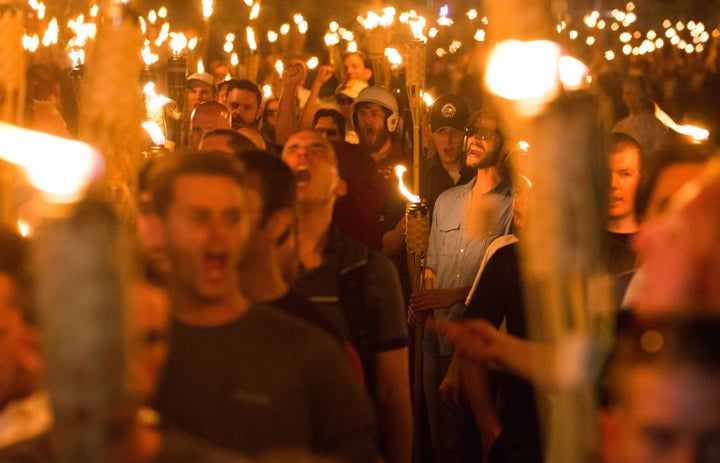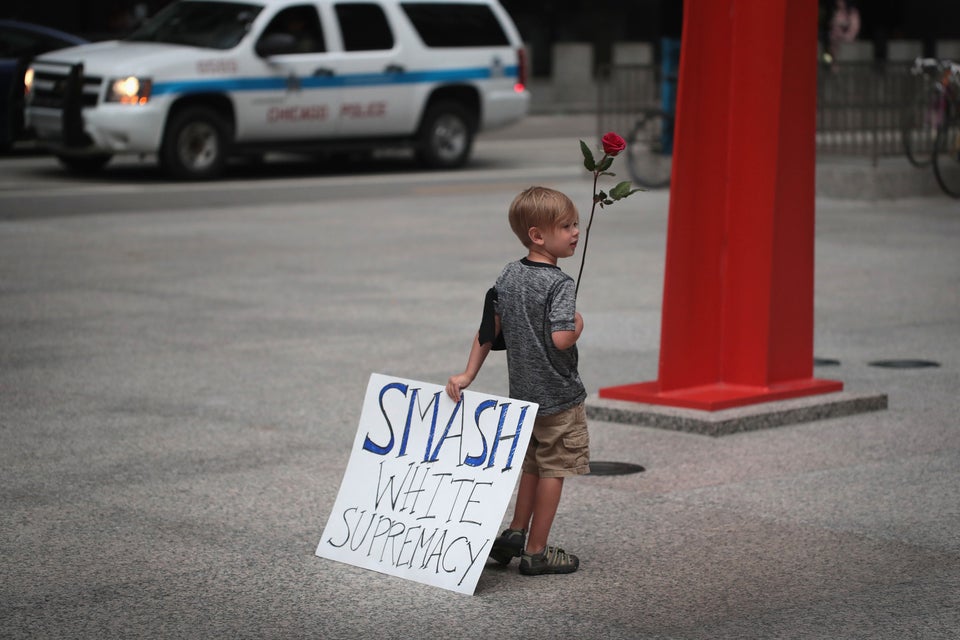
After a violent white supremacist rally in Charlottesville, Virginia, and President Donald Trump’s mealy-mouthed statements failing to properly denounce it, a secret Facebook group’s page lit up with posts.
The members shared shocking images of the rally’s flaming torches in the night and the open display of swastikas. They grieved for Heather Heyer, a 32-year-old paralegal who was killed while protesting racism. They vented about Trump, whose botched reaction to the events in Charlottesville spurred mass condemnation.
Then they turned the conversation to themselves. The people they saw rallying behind hate reminded them of who they used to be.
The posters were all former white supremacists who were brought together by an online support group run by Life After Hate, a nonprofit dedicated to helping people leave violent far-right groups.
Angela King, 42, who co-founded the nonprofit, said that over the past week, dozens of former white supremacists and neo-Nazis took to the private message board to express their complicated feelings of anger, sadness, depression and, also, guilt.
“For individuals who were involved at a large scale, we never really know if what we did is having an impact on the people who are now out there marching with swastikas,” she said.
“We try to plant seeds. It is possible to change and to have a different life.”
- Angela King
The U.S. has seen a dramatic rise in the number of hate groups since the turn of the century, which the Southern Poverty Law Center attributes, in part, to anger over projections showing that whites will become a minority by 2040. In recent years, white nationalist groups, organized loosely under the “alt-right” umbrella and buoyed by Trump’s campaign and election, have gained more visibility.
“Since the era of formal white supremacy ― right before the Civil Rights Act when we ended [legal] segregation ― since that time, this is the most enlivened that we’ve seen the white supremacist movement,” Heidi Beirich, the director of the Intelligence Project at the SPLC told ABC News.
For those who have left the movement, transforming their lives to reject racism and extremism, the events in Charlottesville have been painful to watch. But in interviews with HuffPost, many “formers” ― people who have left the life and chosen to speak out about it ― said they’ve become even more motivated to spread the message that there is a path out of hate.
“We try to plant seeds,” King said. “It is possible to change and to have a different life.”
It’s generally difficult to study current white supremacists, whose beliefs are highly stigmatized in U.S. public life. But researchers are now turning to “formers” like King to begin to understand what draws people to right-wing extremist movements in the first place, what makes them leave those movements and what helps them stay out.
Pete Simi, sociology professor at Chapman University and an expert on political extremist movements, has interviewed dozens of former hate group members and found that many have experienced childhood trauma and have mental health or substance use problems at rates higher than the national average. In a 2016 study interviewing 44 former supremacists, 45 percent recalled physical abuse, 21 percent experienced sexual abuse and 46 percent said they were neglected as children.
While it should be noted that these numbers cannot be construed as representative of the entire movement because of the small sample size, this is one of the only in-depth studies to examine former violent extremists.
Simi said vulnerable teens with tough family lives may end up under the thrall of white supremacists who offer them support ― either through serendipity or targeted recruitment methods.
“King emphasized that it is not the responsibility of people of color or minorities to reach out and befriend violent racists.”
King said she was raised in south Florida in a rural area with “almost zero diversity,” and was bullied in school. When she was 15, she fell in with the neo-Nazi skinhead movement. “They seemed like a perfect fit because I never had to explain my anger,” she said. “I never had to talk about why I was so aggressive and why violence was my means of communication.”
She left the hate group after she was incarcerated for her part in an armed robbery of a Jewish-owned store. That’s common, Simi said. While it’s rarely one thing or event that makes people realize that they need to step away from racist extremism, his research found that incarceration played a major role in several people’s decisions to leave their groups.
For King, a turning point was when when a group of Jamaican women befriended her behind bars.
“They didn’t let me off the hook, but they treated me as a human being and they asked me really tough questions that held me accountable,” she said. “When they were able to see me and treat me as a human being I was able to see myself that way again.”
Simi’s study also finds that disillusionment is another major factor that helps people decide to leave, along with experiencing acts of love and compassion. In fact, marriage and children are often cited as things that give people the strength to leave the all-encompassing ideology. But it could even be as simple as a stranger showing them kindness when they didn’t expect it and least deserved it.
Frank Meeink, a former skinhead who had his own cable-access TV show called “The Reich,” said empathy is a far better weapon than violence.
He described one instance when he was marching with the Ku Klux Klan and was pelted with objects.
“I never once ducked a bottle and thought ‘Woah, I better rethink my belief system here,’” he said. “Instead it was, ‘Now I’m angry. Now I have an enemy I can see.’”
King emphasized that it is not the responsibility of people of color or minorities to reach out and befriend violent racists like she was. The most effective communicators tend to be people like her — former supremacists who have left hate behind.
Her organization Life After Hate helps people who want to leave the movement by hooking them up to therapists and counselors. They also help connect them to tattoo removal services, job training, and mentorship from other people with similar histories.
Life After Hate won a $400,000 grant from the Department of Homeland Security under former President Barack Obama, but the award was revoked once Trump took office and re-routed to groups focusing on “radical islamic terrorism.” This has come under scrutiny in the wake of the Charlottesville violence.
Bryon Widner, a former white power member who was featured in the 2011 documentary “Erasing Hate,” said the biggest challenges he faced after leaving the movement was relearning how to deal with everyday life.
“Like by not resorting to violence every chance I got, that took a bit,” he said.
He also struggled because his face was covered in racist tattoos, which were slowly removed. “That was a massive drawback unto itself. At that time, even though my heart changed, I could not reflect that back.”
Many people are driven into the movement because of trauma in their past, said Timothy Zaal, a former neo-Nazi skinhead who almost killed a gay man in his youth. If those issues aren’t addressed once they get out, he said, they may struggle to find their footing.
“Once you leave, now there’s that void again,” he said. “Do you mask it with mind-altering substances, or distractions, or do you replace it with positivity?”
“It’s fairly clear that because our current administration has been so lax in taking a stand against white supremacy and violent far-right extremists, it has done nothing but embolden them.”
- Angela King
Some “formers” may still experience intrusive racist and hateful thoughts that occasionally even lead to old racist behaviors. For those who have completely renounced their former lives and made total transformations, these thoughts and actions are shocking and distressing.
In an upcoming study, set to be published later this year in the American Sociological Review, Simi and other researchers find that a large portion of 89 former white supremacists in the study used the language of addiction and relapse to describe what’s going on in their lives. The study participants said that after indoctrination by extremist groups, hearing certain music, seeing Nazi insignias and even reading the Bible verses sometimes triggered memories of white supremacist pride even though they had transformed their lives and cut ties with their hate group friends.
King said that it’s important to understand that individuals do not join these groups because they are inherently evil.
“People who are happy are not out there brandishing torches or swastika flags or Confederate flags that drag up the negative aspects of our country’s history,” she said. “No matter how that individual looks on the outside, we don’t know what’s going on on the inside without dialogue.”
However, having a president who appears to be legitimizing factions of the alt-right movement may inflame and incite those on the path to white supremacy.
All the “formers” that HuffPost spoke to expressed disappointment with Trump for his response to the violence in Charlottesville and fear for the future.
“It’s fairly clear that because our current administration has been so lax in taking a stand against white supremacy and violent far-right extremists, it has done nothing but embolden them,” said King. “They have just been handed a mainstream platform and a get-out-of-jail-free card.”
America does not do a good job of tracking incidents of hate and bias. We need your help to create a database of such incidents across the country, so we all know what’s going on. Tell us your story.
